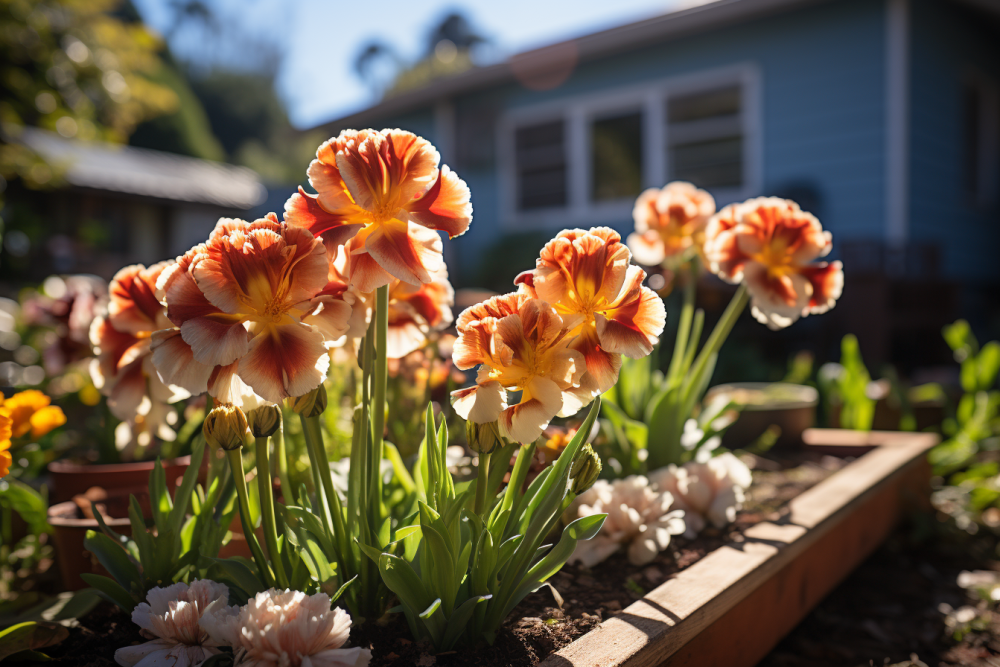Table of Contents
Enhancing Your Vegetable Patch with Blooming Beauty: Integrating Flower Planting in Your Garden
Hey there, green thumbs! Are you tired of your vegetable garden lacking a little pizzazz? Well, look no further, because we’ve got a blooming good idea for you – integrating flower planting in your veggie patch!
Sure, growing your own vegetables is awesome – nothing beats the satisfaction of plucking those ripe tomatoes or crisp lettuce leaves straight from the ground. But why not take it up a notch and add a splash of color and vibrancy to your garden? By planting flowers alongside your veggies, you not only beautify your plot but also reap the benefits of attracting beneficial insects, such as pollinators, to aid in the growth of your edible plants.
Imagine this: a row of radiant marigolds delightfully intermingled with your rows of juicy carrots. Or how about a cluster of bright sunflowers towering above your bushy bean plants? It not only adds visual interest but also helps to naturally deter pests and create a more balanced ecosystem in your garden.
The best part is, flowers come in a dazzling variety of shapes, sizes, and colors, giving you endless options to mix and match with your vegetable crops. So, whether you have a small raised bed or a vast backyard garden, there’s always room to incorporate some floral flair.
In this guide, we’ll explore the benefits of integrating flowers into your veggie garden, share some fantastic flower options to complement your veggies, and offer tips on how to maintain this harmonious combination. Get ready to dig in and create a garden that’s not only productive but also blossoming with beauty!
The Benefits of Flower Planting in Your Vegetable Garden
Flowers aren’t just pretty additions to your vegetable garden; they bring a host of benefits that can take your gardening experience to the next level. Here are some compelling reasons why integrating flower planting into your vegetable garden is a fabulous idea:
- Improved Pollination: Flowers act as magnets for beneficial insects like bees, butterflies, and hummingbirds. These pollinators are essential for the fertilization and fruit set of many vegetables. By attracting them to your garden with colorful blooms, you’ll ensure a healthier yield of fruits and vegetables.
- Natural Pest Control: Certain flowers have properties that repel pests or attract beneficial insects that prey on them. For example, marigolds emit a fragrance that repels many common garden pests like aphids and nematodes. Planting them alongside your vegetables can help deter these unwanted critters, minimizing the need for harsh pesticides.
- Enhanced Biodiversity: Introducing flowers into your vegetable garden nourishes biodiversity. Different species of plants attract a diverse range of insects, birds, and wildlife. This biodiversity creates a more resilient ecosystem, promoting a healthier garden overall.
- Aesthetically Pleasing: Let’s not forget the sheer beauty flowers bring to your garden. The vibrant colors and fragrant blossoms can uplift your spirits and create a peaceful garden oasis. Plus, the visual contrast between flowers and vegetables adds visual interest and makes your garden a delight to behold.
- Companion Planting: Certain flowers have synergistic relationships with vegetables. For example, nasturtiums repel pests that commonly attack cucumbers, while also attracting pollinators. By strategically planting flowers alongside specific vegetables, you can create beneficial relationships that improve overall plant health and productivity.
Incorporating flowers into your vegetable garden not only enhances the aesthetics but also provides numerous practical advantages. From increased pollination and pest control to improved biodiversity and companion planting, the benefits are undeniable. So, get ready to add a splash of color and reap the rewards by integrating flower planting in your vegetable garden.
Choosing the Right Flowers for Your Vegetable Garden
When it comes to integrating flowers into your vegetable garden, selecting the right blooms is key. Here are some essential aspects to consider when choosing flowers for your veggie patch:
- Pollinator-Friendly:
- Opt for flowers that attract pollinators like bees, butterflies, and hummingbirds. These insects play a crucial role in fertilizing your vegetables.
- Favorites include lavender, sunflowers, zinnias, and cosmos, which are known to entice pollinators with their nectar-rich blooms.
- Complementary Colors and Heights:
- Choose flowers with colors that complement your vegetable plants and add visual appeal.
- Consider the heights of both the flowers and vegetables to ensure they don’t overshadow or obstruct each other’s growth.
- Beneficial Properties:
- Some flowers possess properties that repel pests or enhance the growth of nearby vegetables.
- Marigolds, for instance, are effective at deterring aphids and nematodes, while borage attracts pollinators and improves the flavor of tomatoes.
- Seasonal Considerations:
- Pay attention to the blooming seasons of the flowers you choose. Opt for varieties that will bloom alongside your vegetable plants to provide consistent color and pollination support.
- Space and Maintenance Requirements:
- Assess your garden space and choose flowers that fit comfortably alongside your vegetable patches.
- Consider the maintenance needs of the flowers, such as watering, pruning, and deadheading, and ensure they align with your gardening routine.
Remember, the goal is to create a harmonious and functional garden space where flowers and vegetables thrive together. By carefully selecting flowers that attract pollinators, offer beneficial properties, complement your vegetables, and suit your garden’s conditions, you’ll have a winning combination that enhances both the productivity and beauty of your vegetable garden.
Companion Planting: Flowers That Enhance Your Vegetable Crops
When it comes to integrating flowers into your vegetable garden, choosing the right companions can make all the difference. Here are some flower options that can enhance the growth and flavor of your vegetable crops:
- Nasturtiums: These vibrant flowers are not only stunning but also serve as excellent companions for vegetables like cucumbers, squash, and tomatoes. Nasturtiums repel pests like aphids and attract beneficial insects, promoting a healthy garden ecosystem.
- Calendula: Known for its bright orange or yellow petals, calendula is a fantastic addition to any vegetable garden. It repels pests, attracts pollinators, and makes a great companion for lettuce, tomatoes, and beans.
- Borage: With its attractive blue flowers, borage is a beneficial companion for various vegetables, including tomatoes, squash, and strawberries. It attracts pollinators, helps deter pests, and its aromatic leaves improve the flavor of nearby plants.
- Lavender: Not only does lavender add beauty and a delightful scent to your garden, but it also attracts pollinators while repelling pests. Plant it near vegetables like cabbage, broccoli, and cauliflower to help deter cabbage moths.
- Chamomile: Apart from its soothing properties, chamomile is a fantastic companion for cabbage, onions, and cucumbers. It attracts beneficial insects and improves the flavor of nearby herbs and vegetables.
Remember to plant flowers strategically throughout your garden, placing them near the vegetables they benefit the most. By choosing the right companion flowers, you create a diverse and harmonious ecosystem that promotes healthy growth, deters pests naturally, and enhances the flavor of your beloved vegetable crops.
Creating a Colorful and Functional Garden: Flower Arrangement Tips for Vegetable Gardens
Integrating flowers into your vegetable garden not only adds beauty but also enhances the overall functionality of your space. Here are some tips to help you create a colorful and functional flower arrangement in your vegetable garden:
- Mixed Flower Beds:
- Create mixed flower beds that blend beautifully with your vegetable patches. Consider a combination of tall flowers like sunflowers or hollyhocks, mid-size flowers such as marigolds or zinnias, and low-growing varieties like alyssum or lobelia.
- Place taller flowers towards the back or sides of your beds to avoid shading your vegetables.
- Border Plantings:
- Define your vegetable garden borders with a row of flowers. Choose compact varieties like petunias or impatiens and opt for colors that complement your vegetable plants.
- Border plantings help create a visual distinction between the flower and vegetable sections while providing a beautiful frame for your garden.
- Vertical Planters and Trellises:
- Utilize vertical spaces in your vegetable garden by incorporating flowers in hanging baskets, wall planters, or trellises.
- Consider trailing flowers like nasturtiums or fuchsia for hanging baskets, or climbing varieties like morning glories or sweet peas on trellises to add height and vertical interest.
- Container Gardening:
- Plant flowers in containers and place them strategically throughout your vegetable garden. This allows for flexibility in arranging and relocating the flowers as needed.
- Mix flowers of different colors, textures, and heights in each container to create eye-catching displays.
Remember to consider the growth habits and watering needs of both your flowers and vegetables when arranging them together. Strive for a harmonious balance where the flowers don’t overshadow or compete with the vegetables for resources. By using these flower arrangement tips, you can create a visually appealing and functional garden that combines the beauty of flowers with the productivity of your vegetable crops.
Conclusion
In conclusion, integrating flower planting in your vegetable garden is a game-changer for both the aesthetics and functionality of your green space. By carefully selecting the right flowers, you can enhance pollination, attract beneficial insects, deter pests, and create a beautiful visual display.
Flowers not only add pops of color and fragrance to your garden but also contribute to a more balanced and sustainable ecosystem. The presence of vibrant blooms creates a welcoming habitat for pollinators like bees and butterflies, ensuring the successful and abundant production of your vegetable crops.
Furthermore, companion planting flowers with your vegetables creates symbiotic relationships that benefit both plant types. Some flowers repel pests, improving the health and resilience of your vegetable plants, while others improve the flavor of nearby crops or provide shade and support.
So, don’t just settle for a plain old vegetable patch. Spruce it up with the magic of flowers! Whether it’s mixed flower beds, border plantings, vertical planters, or vibrant container gardens, the possibilities are endless. Get creative, experiment with different flower varieties, and watch as your garden transforms into a haven of beauty and productivity.
Remember, gardening should be a joyful and fulfilling experience. Don’t be afraid to get your hands dirty and have fun while creating a harmonious blend of flowers and veggies in your garden. Happy planting!









